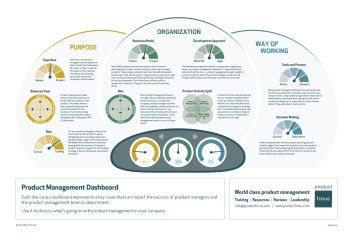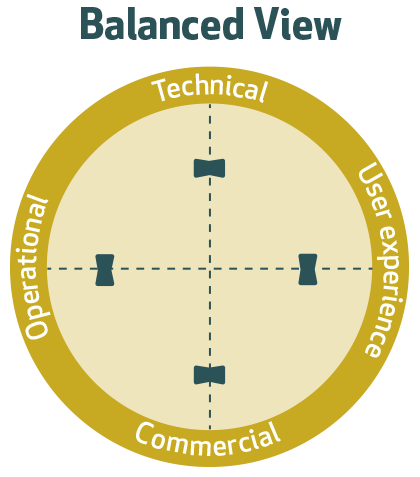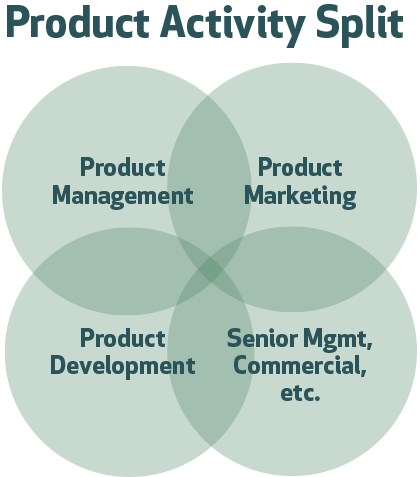
Our Product Management Dashboard is one of the unique tools we use with our clients.
It’s based on our experience of working with many different technology companies over the past 12 years. It identifies key areas that have a big impact on the performance of product management.
We developed the idea of the dashboard in our Product Management Journal – Take Control. Now we’ve further refined and simplified things to create an infographic that we hope will be interesting and useful for everyone.
You can download a copy of the dashboard below.
How the Product Management Dashboard works
The dashboard contains a series of dials each representing a key issue that can impact the success of product management. There’s no mathematical model that determines the position of the pointer on a dial and we find that such precision is rarely necessary. Instead, the dials are used to help facilitate a discussion about how a particular aspect of product management is being done. By discussing where the needle is on the dial for your business at the moment, and where ideally it should be, you can start to set goals for what you’d like to improve.
The dials on the Product Management Dashboard are organized into three sections – Purpose, Organization, and Way of Working.
Purpose
These first three dials focus on what the purpose of product management is in your business.
Expertise: Over time most product managers become experts on their product, but the business also looks to them to decide what goes on the roadmap. This means also knowing about their customers, competitors, and markets. We often see an imbalance, frequently product managers are focused too much on being the expert on their product and don’t spend enough time understanding their market.
Balanced view: Product managers need to have a balanced view of all the different aspects of their product. This allows them to make unbiased decisions and recommendations for the business. It’s not about being an expert on every detail but about having the best ‘helicopter view’ of your product.
Role: For most product managers there is too much focus on the tactical. It’s about firefighting and responding, rather than being strategic, longer-term, and proactive. We believe the role should also be about leading within the business. Driving the product forward in support of the company strategy. Product managers should have one foot in the present and one foot in the future. We know from our 2018 annual survey that the average product manager spends 50% of their time firefighting – we think this is much too high.
Organization
The next four dials look at how things are organized.
Bias: What product management does is strongly influenced by the overall bias within a business. In a Sales led company product managers can find the roadmap is always driven by the latest customer discussions. In a Development led company the focus is on supporting the developers. This is even more marked when product management reports into one of these functions. From our 2018 annual survey, we know that 39% of product management teams report directly through to the board which we would support as the ideal set-up if you want to have an unbiased function.
Development approach: The development approach used in a company has a big impact on product management. Whether it’s Agile, Waterfall, or some hybrid of the two – product management can get caught in a clash of cultures. And if the product manager is also a Scrum Product Owner they can be too busy to do the rest of the role.
Product activity split: Product activities are typically split across a number of departments within a business. Problems arise when it’s not clear who owns what, or when there are gaps or overlaps. Most companies have issues in this area and we recommend using our Product Activities Framework to help think them through.
Business model: Many B2B companies do too much project work. It’s about delivering bespoke customer projects rather than reusable products. These unique solutions cost more to build and support than using off-the-shelf products. They lose the economies of scale, chance to build Intellectual Property, and resulting profitability of a product approach. That’s why there is often a push to ‘productize’ a solution. The goal is to build once and sell many times.
Way of Working
The final two dials look at the way product managers work within a business.
Tools and processes: Many product managers do things in an ad-hoc way but it’s much more efficient if everyone uses the same tools and processes. Using standard approaches means all the stakeholders understand what’s going on, work can be re-used, and things can be improved over time. It’s even better if they are industry best practices!
Decision making: Many companies have woeful product reporting and poor market insight. That means that decisions are often made by gut feeling rather than by analyzing whatever data is available. Gathering the data takes effort but without it, decisions are hard to defend and easily overturned.
Summary
You may find you have other dials you want to add. You may think that some are just not relevant to your business, but we hope you find our Product Management Dashboard a useful tool.
We think it can help identify some of the key challenges product management has in any business. It’s a tool to discuss and communicate what’s going wrong, what could be improved and how things could change.
As a product management leader – if you want to find out more about the unique tools we have and learn how to create a world-class product function, why not come along to our Leading Product Management course. We talk about the Product Management Dashboard and show you how to create a roadmap for improving product management in your business to create a world-class function.
Ian Lunn
Director, Product Focus




Leave a comment